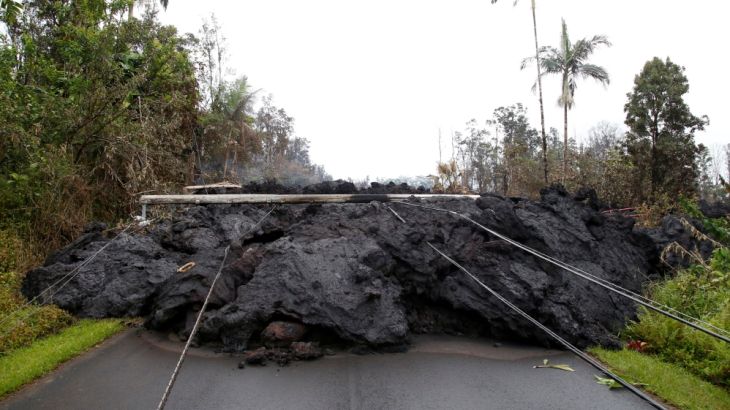Hawaii’s Kilauea volcano: When, why and what’s next
Latest eruption from Mount Kilauea forces at least 1,700 residents to evacuate their homes.

Several earthquakes struck Hawaii after a massive eruption of the Kilauea volcano on the US state’s Big Island.
About 1,700 residents have been ordered to evacuate their homes and some of them may not return for quite some time.
Here is what we know so far:
What happened?
-
On May 3, 2018, Hawaii’s Big Island was on high alert after the Kilauea volcano erupted, spurting lava near the island’s eastern edge; the eruption was preceded by hundreds of earthquakes.
-
After the eruption, an earthquake took place on May 4, measured at magnitude 6.9 hitting the south flank of the volcano at 12:33pm (local time) the most powerful to hit the island since 1975.
-
The Kilauea volcano not only produced the strongest earthquake, but it also opened fissures inside Leilani Estates, sending lava into residential areas.
- In a 48-hour period, experts detected 152 quakes of magnitude 2 to 3, and 22 of magnitude 3 within five kilometres of the volcano’s crater.
-
Around 1,700 people were forced to evacuate, the number of houses destroyed went to 26 on Sunday as scientists reported lava spewing more than 61 meters in the air.
-
Lava has spread around 36,000sq meters, surrounding the most active fissure. About 240 people and 90 pets spent Saturday night (May 5) at shelters.
-
“The challenge with this activity is the fact that it occurred in a populated area, now the question is ‘Will it stay in that area, will it move to another part and how long will it last?'” Diana Roman, a volcanologist told Al Jazeera.
|
|
Kilauea
-
Kilauea is one of the world’s most active volcanoes in the world, continuously erupting since 1983.
-
Normally, the lava flows through subterranean channels to the sea. But the new eruptions are following a different pattern.
- The USG’s Hawaiian Volcano Observatory issued a notice in mid-April stating that there were signs of pressure building in the underground magma.
-
The volcano is close near several small Hawaiian towns that could be affected by the eruption.
|
|
Updates
-
On May 22, officials warned people to stayinside to avoid dangerous clouds of acid fumes, which are being spread by the wind.
-
Hawaii’s Big Island continues to experience violent eruptions. Lava has now reached a geothermal plant that supplies 25 percent of the island’s electricity, destroying a warehouse.
- On May 18, the Mount Kilauea volcano erupted from its summit before dawn at around 4am local time (14:00 GMT), the US Geological Survey said in a statement.
- Hawaii’s Civil Defence Agency warned the ash plume would likely “cover the surrounding area” and advised the island’s residents to “shelter in place”.
- On May 9, the Kilauea volcano erupted again, spewing toxic gases out of two new vents and prompting authorities to call for an immediate evacuation.
- “Hawaiian Volcano Observatory confirms two new vents. All Lanipuna residents must evacuate now,” the County said in its bulletin, adding that the two vents had opened near two road intersections and were “actively erupting”.
- Earlier on Tuesday, residents of the hardest hit area, known as Leilani Estates, drove through clouds of sulfur and over cracked roads to make desperate, and possibly last, visits to their homes before another eruption.
- Residents of a second area, Lanipuna Gardens, were barred from returning home on Monday due to volcanic gases.
- At least 35 structures have been destroyed on Hawaii’s Big Island, Hawaii Civil Defense reported on Monday, and a total of 12 fissures have emerged.
- Lava is still spewing, officials said. Scientists say there’s no way to predict when the eruption will end. It could be days, months or longer.
-
The state’s Department of Education announced all public schools on the Big Island will open on Monday, May 7.
-
Air quality will be monitored, if the air quality drops, schools are prepared to shelter-in-place in designated locations.
-
Leilani Estates residents are allowed to continue evacuation to check on their property from 7am to 6pm (local time) each day until further notice. The residents of the Lanipuna Gardens subdivision are prohibited from accessing their homes due to gases.
- The Hawaiian Volcano Observatory reported that fissure eruptions have been continuous.
- Aftershocks have continued seismic activity at Kilauea’s remains elevated.
Be prepared to evacuate at moment's notice
In Pictures
![Lava spatters from the Kilauea volcano near Pahoa, Hawaii [USGS via AP]](/wp-content/uploads/2018/05/3bebadf900634069bb15422a91917255_18.jpeg)
![Lava engulfs a Ford Mustang in Puna, Hawaii, on May 6, 2018, in this still image obtained from a social media video [Reuters]](/wp-content/uploads/2018/05/0ea9b914b8ae44b89ed66926d51c6a8d_18.jpeg)
![Puna district residents attend a community meeting during ongoing eruptions of the Kilauea Volcano at Pahoa High and Intermediate School [Terray Sylvester/Reuters]](/wp-content/uploads/2018/05/0d50b0ad34cb417f8860e86fa65c1367_18.jpeg)
![Handout photo of a new fissure spraying lava fountains as high as about 230 feet (70 metres), according to United States Geological Survey, is shown from Luana Street in Leilani Estates subdivision on Kilauea Volcano's lower East Rift Zone in Hawaii [Reuters]](/wp-content/uploads/2018/05/ef5b8504da1d47bd828378958e5784c0_18.jpeg)
![A plume of gas mixed with smoke from fires caused by lava rises, centre, amid clouds in the Leilani Estates neighborhood in the aftermath of eruptions from the Kilauea volcano on Hawaii's Big Island on May 6, 2018, in Pahoa, Hawaii [Mario Tama/Getty Images]](/wp-content/uploads/2018/05/f93767cc1371482180834b18ad92279d_18.jpeg)